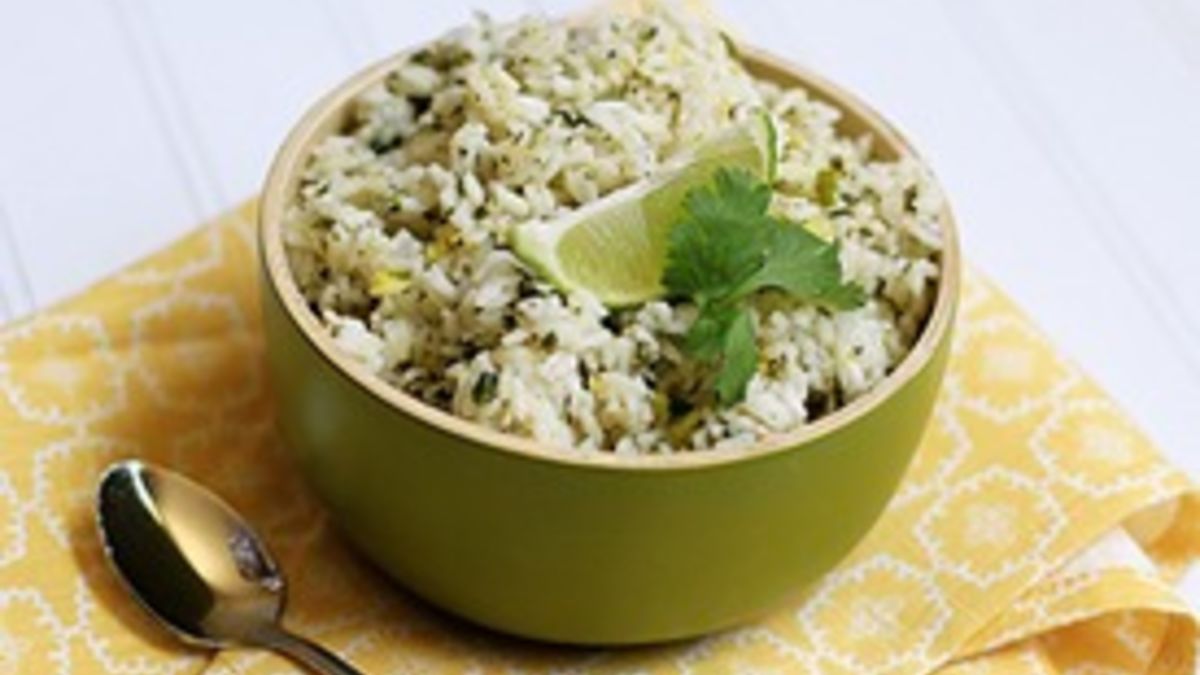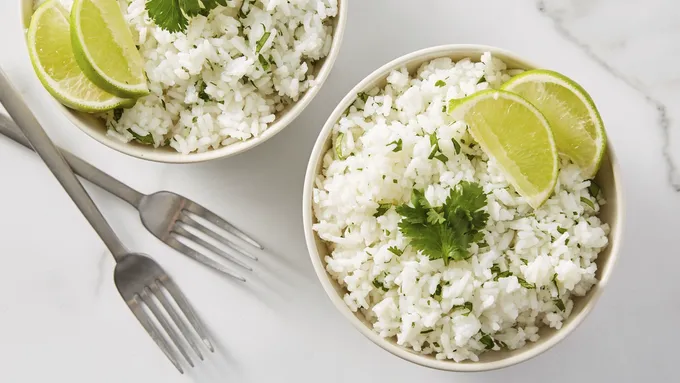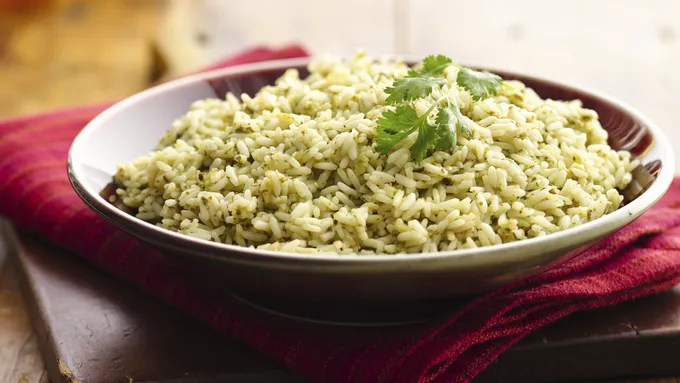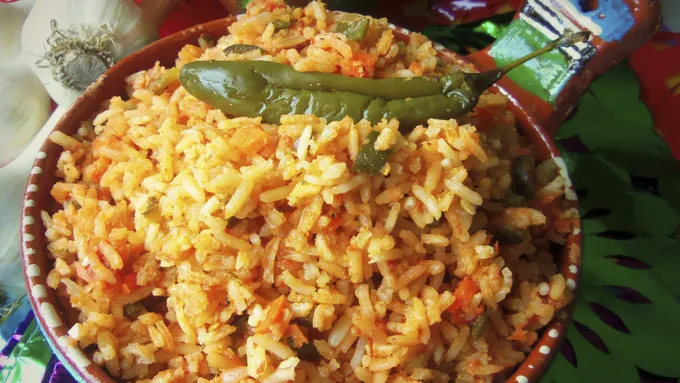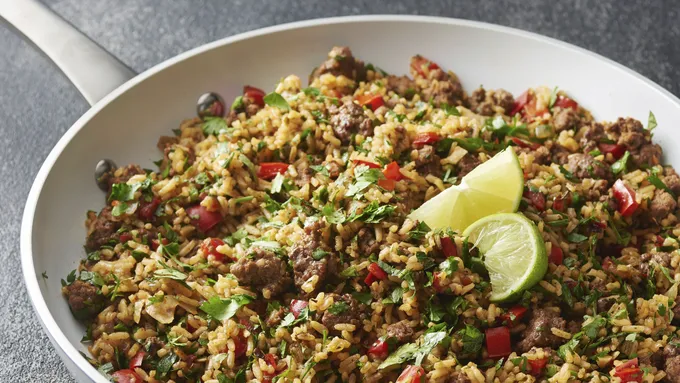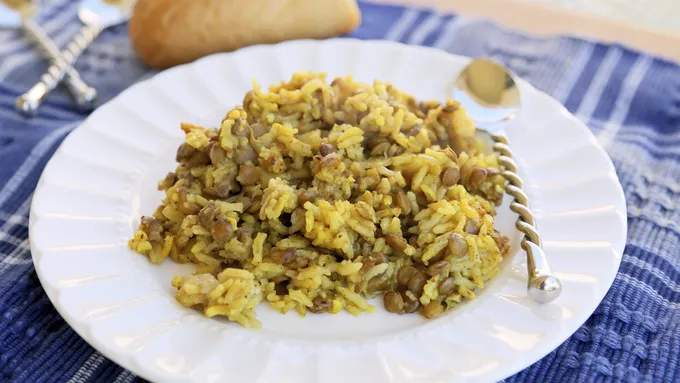Cilantro Lime Rice
Good Life Eats
Updated Mar 6, 2017
Take a break from the common Spanish rice and serve this Cilantro Lime Rice with your next Mexican meal.
More About This Recipe
- Cilantro is exotic, fun, and a little strange. So what is it exactly? And what makes it so great? It sounds kind of exotic. But, what is cilantro? Cilantro is actually a fresh herb used in Southwest and Mexican cooking. It's a unique herb – many studies show that about half of people who have tried cilantro find it delicious while the other half finds the taste soapy and the smell disgusting. Curiously enough, people of European descent will often fall in this second group even though cilantro is found natively in Southeast Europe. For those who can like it, cilantro is like a blend of caraway, lemon, and sage.
- Cilantro is the Spanish name for the leaves harvested from the coriander plant. The leaves are small, green, and sold fresh—they resemble veined clovers with frayed ends. Cilantro has seen a lot more attention in modern cooking, but the coriander plant it comes from was cultivated and harvested in Israel before pottery was even created. Cilantro's biggest audience, the American Southwest and Mexico, uses it for a lot of things like salsa, salads, burritos and meat dishes. You’ll even seen it in Brazilian-style steakhouses where it is used in a pesto as a dipping sauce for cuts of meat.
- Cilantro is found fresh in most grocery stores and is available year-round. When selecting your cilantro leaves, you should be on the lookout for tender and aromatic leaves that are very green. Avoid wilted bunches and leaves without a strong smell. No aroma when you pinch the leaves mean the cilantro will have no flavor – and what's the point of that? Storing cilantro is a lot like storing parsley – keep it in an airtight container or wrapped in a bag and use it or lose it within a week (or less). You may also find dried cilantro in the spice rack, but the flavor doesn't hold up very well, if at all. Cilantro is an herb that everyone should try at least once—experiment with it to help brighten up a salad or add a rich and flavorful taste to cooked meats.
- Turn that fresh bundle of cilantro into these delicious recipes.
Cilantro Lime Rice
- Prep Time 5 min
- Total 25 min
- Servings 4
- Ingredients 11
Ingredients
- 1/3 cup white rice
- Scant 1 1/3 cup water
- Scant 1 1/3 cup chicken broth, preferrably organic and all-natural
- 1 teaspoon olive oil
- Juice of 1 lime
- 1/4 teaspoon salt plus more to taste (if desired)
- 1/2 teaspoon ground cumin
- 1/4 teaspoon black pepper
- Zest from 1 lime
- 1/3 cup thinly sliced green onion
- 1/2 cup chopped finely cilantro
Instructions
-
Step1Combine water through pepper in a medium sized pot over medium-high heat.
-
Step2Bring to a rolling boil. Turn heat to low. Cover with a lid and simmer for 17 minutes.
-
Step3Turn heat off, and with the lid still on, let the rice steam an additional 5 minutes.
-
Step4Remove the lid, fluff with a fork and stir in the lime zest, green onion, and cilantro. Serve.
Nutrition
No nutrition information available for this recipe
(function() {
document.addEventListener('DOMContentLoaded', function() {
var componentMetadata = JSON.parse('\x7b\x22componentName\x22\x3a\x22RelatedContent_86838426-dd26-481a-9735-69435bca607d\x22,\x22deferOptions\x22\x3a\x7b\x22deferComponent\x22\x3afalse,\x22deferType\x22\x3a\x22None\x22,\x22deferId\x22\x3a\x22r1637d49aa191430f859a48451ac0489d\x22,\x22deferredContainerId\x22\x3a\x22\x2fmain\x2frdpRelatedContent1_NonDeferred\x22,\x22deferredContainerView\x22\x3anull\x7d,\x22viewName\x22\x3a\x22RelatedContent\x22\x7d');
var configuration = {"dataSourceId":"86838426-dd26-481a-9735-69435bca607d","isCurrentUserAnonymous":true,"isAnonymousUserWithFavorites":false,"relatedContentList":{"contentId":"ac6bdf72-787c-4406-8911-ccb609a53838","listSettings":{"pageSize":3,"startPage":1,"listType":1,"title":"Try These Next","useModalRegistration":false,"regAction":"","esrcCode":0,"favoriteButtonLabelFormat":"Add {0} to favorites","contentTypes":["Category"],"showImages":false,"imageSize":0,"showRatings":false,"allowFavoriting":false,"cssClassName":"relatedContentWithoutImages","favoriteButtonText":""},"items":[{"contentId":"f5d7ba6d-a251-4060-84b1-d4d41920dcdf","contentType":"Category","title":"Mexican Recipes, Dishes and Ideas from Tablespoon","isFavorite":false,"linkUrl":"/courses/dinner/world-cuisine/mexican","numberOfRatings":"0","averageRating":"0","averageRatingStars":"0","smallImageUrl":"https://rms-media-prod.generalmills.com/b3732bfd-f9d1-4ace-931e-8dcd7ffedc32.jpg","mediumImageUrl":"https://rms-media-prod.generalmills.com/34cb136a-d327-48df-ba07-867b90353b34.jpg"},{"contentId":"56e3a7c4-2bcc-4849-b433-c8a4f3f855a7","contentType":"Category","title":"Martini Recipes, Dishes and Ideas from Tablespoon","isFavorite":false,"linkUrl":"/courses/drinks/cocktail/martini","numberOfRatings":"0","averageRating":"0","averageRatingStars":"0","smallImageUrl":"","mediumImageUrl":""},{"contentId":"0f52e314-931b-4940-857b-ffc0e43376fa","contentType":"Category","title":"Mimosa Recipes, Dishes and Ideas from Tablespoon","isFavorite":false,"linkUrl":"/courses/drinks/cocktail/mimosa","numberOfRatings":"0","averageRating":"0","averageRatingStars":"0","smallImageUrl":"","mediumImageUrl":""}],"availableItems":[{"contentId":"f5d7ba6d-a251-4060-84b1-d4d41920dcdf","contentType":"Category","title":"Mexican Recipes, Dishes and Ideas from Tablespoon","isFavorite":false,"linkUrl":"/courses/dinner/world-cuisine/mexican","numberOfRatings":"0","averageRating":"0","averageRatingStars":"0","smallImageUrl":"https://rms-media-prod.generalmills.com/b3732bfd-f9d1-4ace-931e-8dcd7ffedc32.jpg","mediumImageUrl":"https://rms-media-prod.generalmills.com/34cb136a-d327-48df-ba07-867b90353b34.jpg"},{"contentId":"56e3a7c4-2bcc-4849-b433-c8a4f3f855a7","contentType":"Category","title":"Martini Recipes, Dishes and Ideas from Tablespoon","isFavorite":false,"linkUrl":"/courses/drinks/cocktail/martini","numberOfRatings":"0","averageRating":"0","averageRatingStars":"0","smallImageUrl":"","mediumImageUrl":""},{"contentId":"0f52e314-931b-4940-857b-ffc0e43376fa","contentType":"Category","title":"Mimosa Recipes, Dishes and Ideas from Tablespoon","isFavorite":false,"linkUrl":"/courses/drinks/cocktail/mimosa","numberOfRatings":"0","averageRating":"0","averageRatingStars":"0","smallImageUrl":"","mediumImageUrl":""}]}};
var moduleName = 'relatedContent';
var isVueModule = true;
GeneralMills.PandoSites.RegisterControlInstance(moduleName, configuration, componentMetadata, isVueModule)
});
})();
(function() {
document.addEventListener('DOMContentLoaded', function() {
var componentMetadata = JSON.parse('\x7b\x22componentName\x22\x3a\x22RelatedContent_9930dad2-817c-4363-b508-21f459b3c521\x22,\x22deferOptions\x22\x3a\x7b\x22deferComponent\x22\x3atrue,\x22deferType\x22\x3a\x22OnDemand\x22,\x22deferId\x22\x3a\x22rc97ebc1fc85d4797a413e091ad9ddbc0\x22,\x22deferredContainerId\x22\x3a\x22\x2fmain\x2frdpRelatedContent1\x22,\x22deferredContainerView\x22\x3a\x22RecipeDetailRedesign\x22\x7d,\x22viewName\x22\x3a\x22RelatedContent\x22\x7d');
var configuration = {"dataSourceId":"9930dad2-817c-4363-b508-21f459b3c521","isCurrentUserAnonymous":true,"isAnonymousUserWithFavorites":false,"relatedContentList":{"contentId":"ac6bdf72-787c-4406-8911-ccb609a53838","listSettings":{"pageSize":6,"startPage":1,"listType":1,"title":"","useModalRegistration":false,"regAction":"","esrcCode":0,"favoriteButtonLabelFormat":"Add {0} to favorites","contentTypes":[],"showImages":true,"imageSize":1,"showRatings":false,"allowFavoriting":true,"cssClassName":"","favoriteButtonText":"Save"},"items":[{"contentId":"1779831b-f727-4c0b-b3d9-ee3bd3ddbafb","contentType":"Recipe","title":"Copycat Chipotle™ Cilantro-Lime Rice","isFavorite":false,"linkUrl":"/recipes/copycat-chipotle-cilantro-lime-rice/1779831b-f727-4c0b-b3d9-ee3bd3ddbafb","numberOfRatings":"0","averageRating":"0","averageRatingStars":"0","smallImageUrl":"//mojo.generalmills.com/api/public/content/-XRl52mymkKlhjTto95_lA_webp_base.webp?v=2e47df83\u0026t=67e847e026fb43aa8d6e3f5ef39a4ef7","mediumImageUrl":"//mojo.generalmills.com/api/public/content/-XRl52mymkKlhjTto95_lA_webp_base.webp?v=2e47df83\u0026t=3653fe2f5ecd4a47a5a51c97e429947c"},{"contentId":"e5f92907-b19c-468e-a677-e8870751aa14","contentType":"Recipe","title":"Cilantro-Parsley Rice","isFavorite":false,"linkUrl":"/recipes/cilantro-parsley-rice/e5f92907-b19c-468e-a677-e8870751aa14","numberOfRatings":"0","averageRating":"0","averageRatingStars":"0","smallImageUrl":"//mojo.generalmills.com/api/public/content/mwE3V-HioUCp48mqen1c1w_webp_base.webp?v=a6d3c071\u0026t=67e847e026fb43aa8d6e3f5ef39a4ef7","mediumImageUrl":"//mojo.generalmills.com/api/public/content/mwE3V-HioUCp48mqen1c1w_webp_base.webp?v=a6d3c071\u0026t=3653fe2f5ecd4a47a5a51c97e429947c"},{"contentId":"ddd8d243-f47d-40c1-a093-d9e0432ccfef","contentType":"Recipe","title":"Red Rice","isFavorite":false,"linkUrl":"/recipes/red-rice/ddd8d243-f47d-40c1-a093-d9e0432ccfef","numberOfRatings":"0","averageRating":"0","averageRatingStars":"0","smallImageUrl":"//mojo.generalmills.com/api/public/content/-jvp0J84Rkep6JqPvIZeuA_webp_base.webp?v=10850c14\u0026t=67e847e026fb43aa8d6e3f5ef39a4ef7","mediumImageUrl":"//mojo.generalmills.com/api/public/content/-jvp0J84Rkep6JqPvIZeuA_webp_base.webp?v=10850c14\u0026t=3653fe2f5ecd4a47a5a51c97e429947c"},{"contentId":"ad7e9273-806b-4a27-b042-e95df0fffa1d","contentType":"Recipe","title":"Chimichurri Beef and Rice Skillet","isFavorite":false,"linkUrl":"/recipes/chimichurri-beef-and-rice-skillet/ad7e9273-806b-4a27-b042-e95df0fffa1d","numberOfRatings":"0","averageRating":"0","averageRatingStars":"0","smallImageUrl":"//mojo.generalmills.com/api/public/content/md8XVLYF9UWLhTT8GqNV2g_webp_base.webp?v=a818ed8a\u0026t=67e847e026fb43aa8d6e3f5ef39a4ef7","mediumImageUrl":"//mojo.generalmills.com/api/public/content/md8XVLYF9UWLhTT8GqNV2g_webp_base.webp?v=a818ed8a\u0026t=3653fe2f5ecd4a47a5a51c97e429947c"},{"contentId":"100cba25-f392-4a0c-b803-75d8911fead7","contentType":"Recipe","title":"Slow-Cooker Curried Rice and Lentils","isFavorite":false,"linkUrl":"/recipes/slow-cooker-curried-rice-and-lentils/100cba25-f392-4a0c-b803-75d8911fead7","numberOfRatings":"0","averageRating":"0","averageRatingStars":"0","smallImageUrl":"//mojo.generalmills.com/api/public/content/-EXHxP6ISUSluRdiFtxoKA_webp_base.webp?v=bf8c0031\u0026t=67e847e026fb43aa8d6e3f5ef39a4ef7","mediumImageUrl":"//mojo.generalmills.com/api/public/content/-EXHxP6ISUSluRdiFtxoKA_webp_base.webp?v=bf8c0031\u0026t=3653fe2f5ecd4a47a5a51c97e429947c"},{"contentId":"e75c2c1a-0f8f-45e2-9a52-fcc22032cb94","contentType":"Recipe","title":"Mexican White Dip","isFavorite":false,"linkUrl":"/recipes/mexican-white-dip/e75c2c1a-0f8f-45e2-9a52-fcc22032cb94","numberOfRatings":"0","averageRating":"0","averageRatingStars":"0","smallImageUrl":"//rms-media-prod.generalmills.com/21444848-5a32-441b-8487-696ec4410c38.jpg","mediumImageUrl":"//rms-media-prod.generalmills.com/c996e95c-73d4-42b7-a3c3-2c9cf5302964.jpg"}],"availableItems":[{"contentId":"1779831b-f727-4c0b-b3d9-ee3bd3ddbafb","contentType":"Recipe","title":"Copycat Chipotle™ Cilantro-Lime Rice","isFavorite":false,"linkUrl":"/recipes/copycat-chipotle-cilantro-lime-rice/1779831b-f727-4c0b-b3d9-ee3bd3ddbafb","numberOfRatings":"0","averageRating":"0","averageRatingStars":"0","smallImageUrl":"//mojo.generalmills.com/api/public/content/-XRl52mymkKlhjTto95_lA_webp_base.webp?v=2e47df83\u0026t=67e847e026fb43aa8d6e3f5ef39a4ef7","mediumImageUrl":"//mojo.generalmills.com/api/public/content/-XRl52mymkKlhjTto95_lA_webp_base.webp?v=2e47df83\u0026t=3653fe2f5ecd4a47a5a51c97e429947c"},{"contentId":"e5f92907-b19c-468e-a677-e8870751aa14","contentType":"Recipe","title":"Cilantro-Parsley Rice","isFavorite":false,"linkUrl":"/recipes/cilantro-parsley-rice/e5f92907-b19c-468e-a677-e8870751aa14","numberOfRatings":"0","averageRating":"0","averageRatingStars":"0","smallImageUrl":"//mojo.generalmills.com/api/public/content/mwE3V-HioUCp48mqen1c1w_webp_base.webp?v=a6d3c071\u0026t=67e847e026fb43aa8d6e3f5ef39a4ef7","mediumImageUrl":"//mojo.generalmills.com/api/public/content/mwE3V-HioUCp48mqen1c1w_webp_base.webp?v=a6d3c071\u0026t=3653fe2f5ecd4a47a5a51c97e429947c"},{"contentId":"ddd8d243-f47d-40c1-a093-d9e0432ccfef","contentType":"Recipe","title":"Red Rice","isFavorite":false,"linkUrl":"/recipes/red-rice/ddd8d243-f47d-40c1-a093-d9e0432ccfef","numberOfRatings":"0","averageRating":"0","averageRatingStars":"0","smallImageUrl":"//mojo.generalmills.com/api/public/content/-jvp0J84Rkep6JqPvIZeuA_webp_base.webp?v=10850c14\u0026t=67e847e026fb43aa8d6e3f5ef39a4ef7","mediumImageUrl":"//mojo.generalmills.com/api/public/content/-jvp0J84Rkep6JqPvIZeuA_webp_base.webp?v=10850c14\u0026t=3653fe2f5ecd4a47a5a51c97e429947c"},{"contentId":"ad7e9273-806b-4a27-b042-e95df0fffa1d","contentType":"Recipe","title":"Chimichurri Beef and Rice Skillet","isFavorite":false,"linkUrl":"/recipes/chimichurri-beef-and-rice-skillet/ad7e9273-806b-4a27-b042-e95df0fffa1d","numberOfRatings":"0","averageRating":"0","averageRatingStars":"0","smallImageUrl":"//mojo.generalmills.com/api/public/content/md8XVLYF9UWLhTT8GqNV2g_webp_base.webp?v=a818ed8a\u0026t=67e847e026fb43aa8d6e3f5ef39a4ef7","mediumImageUrl":"//mojo.generalmills.com/api/public/content/md8XVLYF9UWLhTT8GqNV2g_webp_base.webp?v=a818ed8a\u0026t=3653fe2f5ecd4a47a5a51c97e429947c"},{"contentId":"100cba25-f392-4a0c-b803-75d8911fead7","contentType":"Recipe","title":"Slow-Cooker Curried Rice and Lentils","isFavorite":false,"linkUrl":"/recipes/slow-cooker-curried-rice-and-lentils/100cba25-f392-4a0c-b803-75d8911fead7","numberOfRatings":"0","averageRating":"0","averageRatingStars":"0","smallImageUrl":"//mojo.generalmills.com/api/public/content/-EXHxP6ISUSluRdiFtxoKA_webp_base.webp?v=bf8c0031\u0026t=67e847e026fb43aa8d6e3f5ef39a4ef7","mediumImageUrl":"//mojo.generalmills.com/api/public/content/-EXHxP6ISUSluRdiFtxoKA_webp_base.webp?v=bf8c0031\u0026t=3653fe2f5ecd4a47a5a51c97e429947c"},{"contentId":"e75c2c1a-0f8f-45e2-9a52-fcc22032cb94","contentType":"Recipe","title":"Mexican White Dip","isFavorite":false,"linkUrl":"/recipes/mexican-white-dip/e75c2c1a-0f8f-45e2-9a52-fcc22032cb94","numberOfRatings":"0","averageRating":"0","averageRatingStars":"0","smallImageUrl":"//rms-media-prod.generalmills.com/21444848-5a32-441b-8487-696ec4410c38.jpg","mediumImageUrl":"//rms-media-prod.generalmills.com/c996e95c-73d4-42b7-a3c3-2c9cf5302964.jpg"}]}};
var moduleName = 'relatedContent';
var isVueModule = true;
GeneralMills.PandoSites.RegisterControlInstance(moduleName, configuration, componentMetadata, isVueModule)
});
})();
© 2026 ®/TM General Mills All Rights Reserved
